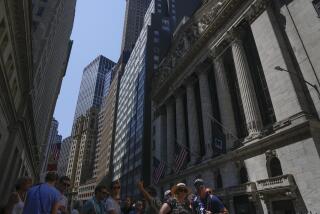Oil prices soar as unrest intensifies in Libya
- Share via
Reports of intensified fighting in Libya propelled oil past $118 a barrel in Europe and to nearly $107 in the U.S., the highest levels since September 2008, with concern growing that the disruption in Libya’s crude-oil production could last longer than initially expected.
Another day of rising oil prices meant falling stock prices. In a roller-coaster session, the Dow Jones industrial average on Monday closed down 79.85 points, or 0.7%, to 12,090.03. The Standard & Poor’s 500 was off 0.8%, and the Nasdaq composite fell 1.4%.
At the fuel pump, the relentless rise continued. California drivers paid an average of $3.874 for a gallon of regular on Monday, up 15.5 cents from a week earlier, the Energy Department said. The U.S. average hit $3.52 a gallon, up 13.7 cents.
Oil is the driving factor behind gasoline’s surge, accounting for about two-thirds of the retail price of a gallon of gas. In New York futures trading Monday, the U.S. benchmark West Texas Intermediate crude for April delivery closed at $105.44 per barrel, up $1.02 from Friday’s close but down from the day’s trading high of $106.95.
The European benchmark Brent crude for April delivery fell 93 cents to close at $115.04 a barrel, after reaching as high as $118.50 earlier in the day, as widespread combat continued in Libya, where as much as 1 million barrels of its typical 1.65 million barrels of daily crude oil production has been shut down.
White House spokesman Jay Carney said Monday that there has been some talk about whether to release oil from the nation’s 727-million-barrel strategic reserve, but Carney added that that might depend on whether there’s been a major disruption in the flow of oil.
The idea of tapping the strategic reserves worries some experts including James DiGeorgia, editor of GoldAndEnergyAdvisor.com.
“What if we tap it now and then need it in an emergency later? Then prices will just go up anyway,” DiGeorgia said.
As long as populist unrest doesn’t spread to Saudi Arabia or Kuwait, oil prices could slowly decline, he said. But if the crisis spreads, “we could be looking at oil at $120 a barrel to $130 a barrel very quickly, and that would take gasoline prices close to $5 a gallon.”
Increasing oil prices are stoking inflation worries, which was reflected in the stock market on Monday. Investors are concerned that companies might raise prices to guard profit margins in the face of higher energy costs.
“With the economy struggling along, the last thing this economy needs is a tax hike, and that’s what you get with higher oil prices and instability in supply,” said A.C. Moore, chief investment strategist at Dunvegan Associates Inc. in Santa Barbara.
More to Read
Inside the business of entertainment
The Wide Shot brings you news, analysis and insights on everything from streaming wars to production — and what it all means for the future.
You may occasionally receive promotional content from the Los Angeles Times.











